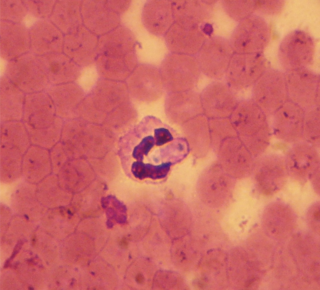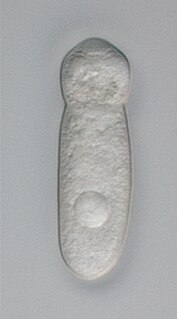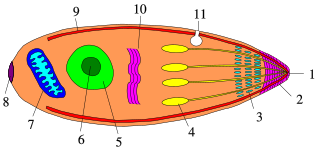
The Apicomplexa are a large phylum of parasitic alveolates. Most of them possess a unique form of organelle that comprises a type of plastid called an apicoplast, and an apical complex structure. The organelle is an adaptation that the apicomplexan applies in penetration of a host cell.
Life cycle, life-cycle, or lifecycle may refer to:

Trematoda is a class within the phylum Platyhelminthes. It includes two groups of parasitic flatworms, known as flukes.

Trematodes are any parasitic flatworm of the class Trematoda, especially a parasitic fluke. While consisting of two suckers, one being ventral and one being oral. They have a tegument covering which helps them with absorption and protection from the environment.

Hepatozoon is a genus of Apicomplexa alveolates which incorporates over 300 species obligate intraerythrocytic parasites. Species have been described from all groups of tetrapod vertebrates, as well as a wide range of haematophagous arthropods, which serve as both the vectors and definitive hosts of the parasite. By far the most biodiverse and prevalent of all haemogregarines, the genus is distinguished by its unique reciprocal trophic lifecycle which lacks the salivary transmission between hosts commonly associated with other apicomplexans. While particularly prevalent in amphibians and reptiles, the genus is more well known in veterinary circles for causing a tick-borne disease called hepatozoonosis in some mammals.

The gregarines are a group of Apicomplexan alveolates, classified as the Gregarinasina or Gregarinia. The large parasites inhabit the intestines of a large number of invertebrates. They are not found in any vertebrates. However, gregarines are closely related to both Toxoplasma and Plasmodium, which cause toxoplasmosis and malaria, respectively. Both protists use protein complexes similar to those that are formed by the gregarines for gliding motility and invading target cells. This makes them an excellent model for studying gliding motility with the goal of developing treatment options for toxoplasmosis and malaria.

Paragonimiasis is a food-borne parasitic infection caused by the lung fluke, most commonly Paragonimus westermani. It infects an estimated 22 million people yearly worldwide. It is particularly common in East Asia. More than 30 species of trematodes (flukes) of the genus Paragonimus have been reported; among the more than 10 species reported to infect humans, and only 8 bringing about infections in humans, the most common is P. westermani, the oriental lung fluke.

Conoidasida is a class of parasitic alveolates in the phylum Apicomplexa. The class was defined in 1988 by Levine and contains two subclasses - the coccidia and the gregarines. All members of this class have a complete, hollow, truncated conoid. Gregarines tend to parasitize invertebrates with the mature gamonts being extracellular, the coccidia mostly infect vertebrates and have intracellular gamonts.

Colpodella is a genus of alveolates comprising 5 species, and two further possible species: They share all the synapomorphies of apicomplexans, but are free-living, rather than parasitic. Many members of this genus were previously assigned to a different genus - Spiromonas.

Apicomplexans, a group of intracellular parasites, have life cycle stages evolved to allow them to survive the wide variety of environments they are exposed to during their complex life cycle. Each stage in the life cycle of an apicomplexan organism is typified by a cellular variety with a distinct morphology and biochemistry.
The web content lifecycle is the multi-disciplinary and often complex process that web content undergoes as it is managed through various publishing stages.
Coitocaecum parvum is a digeneic trematode or flatworm (Platyhelminthes) that is parasitic to the intestine of the common bully or upland bully. The common and upland bully are freshwater fish of New Zealand that C. parvum uses as its definitive host. C. parvum is a hermaphroditic freshwater trematode that can omit its definitive host and produce eggs by selfing or progenesis inside its amphipod second intermediate host
Goussia is a taxonomic genus, first described in 1896 by Labbé, containing parasitic protists which largely target fish and amphibians as their hosts. Members of this genus are homoxenous and often reside in the gastrointestinal tract of the host, however others may be found in organs such as the gallbladder or liver.
The genera Goussia, as current phylogenies indicate, is part of the class Conoidasida, which is a subset of the parasitic phylum Apicomplexa; features of this phylum, such as a distinct apical complex containing specialized secretory organelles, an apical polar ring, and a conoid are all present within Goussia, and assist in the mechanical invasion of host tissue. The name Goussia is derived from the French word gousse, meaning pod. This name is based on the bi-valve sporocyst morphology which some Goussians display. Of the original 8 classified Goussians, 6 fit the “pod” morphology. As of this writing, the genera consists of 59 individual species.

The Haemoproteidae are a family of parasitic alveolates in the phylum Apicomplexa.
Aggregata is a genus of parasitic alveolates belonging to the phylum Apicomplexa.
Vitrella brassicaformis, also known as a 'chromerid', is a species of alveolates isolated from the Great Barrier Reef. Its closest known relative is Chromera velia. Vitrella differs from Chromera in having a more complex lifecycle, for instance involving a range of sizes and morphologies. Also, while Vitrella is greenish coloured, Chromera is brown coloured. The differences are in the types of secondary pigments that characterize each genus. Both genera lack chlorophyll b or c; these absences link the two taxonomically, as algae bearing only chlorophyll a are quite few amid the biodiversity of life. Phylogenetically, both Vitrella and Chromera are relatives of the obligately parasitic phylum Apicomplexa, which includes Plasmodium, the agent of malaria. Both Vitrella brassicaformis and Chromera velia are photosynthetic.
The Archigregarinorida are an order of parasitic alveolates in the phylum Apicomplexa. Species in this order infect marine invertebrates — usually annelids, ascidians, hemichordates and sipunculids.
Grasseella is a genus in the phylum Apicomplexa.
The Schizocystidae are a family of parasitic alveolates in the phylum Apicomplexa. Species in this family infect insects.
Schizocystidae is a genus of parasitic alveolates in the phylum Apicomplexa.










